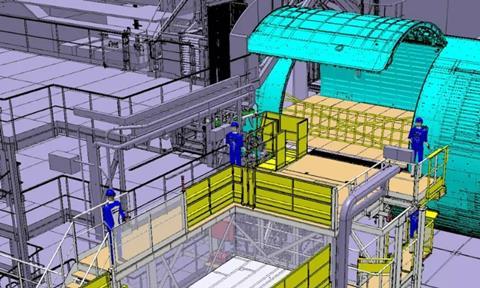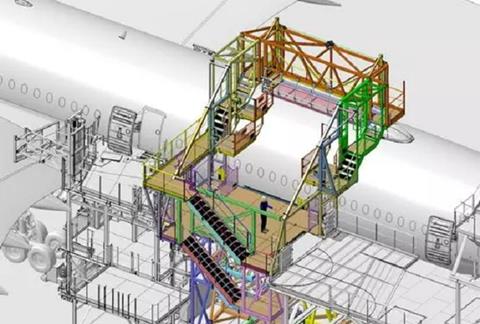Airbus intends to finalise readiness of jigs and tools on its A350 final assembly line over the next six months in order to handle the manufacture of the freighter variant of the twinjet type.
Designated the A350-1000F, the freighter is sized between the -900 and -1000 passenger versions and this, along with its specific design features, has required a reconfiguration of stations on the Toulouse assembly line.
Airbus expects final assembly activity to commence next year. The airframer’s French and German aerostructures operations – Airbus Atlantic and Airbus Aerostructures – are manufacturing the initial large sections of the cargo aircraft.
Along with the industrial progress, Airbus has been filing associated regulatory requests – it has sought granting of special conditions from the US FAA regarding the carriage of up to 11 personnel in the supernumerary cabin behind the cockpit, as well as the pilots’ seats, and cockpit emergency exits.
The airframer has confirmed orders for 55 aircraft and Etihad Airways has recently reportedly exercised options on three more.
Work began last year to modify eight stations on the final assembly line to handle the freighter, and Airbus says the primary changes were completed by the end of October this year.

“The forward part of all our stations – where we want to be freighter-capable – had to be modified, so the main jacks and pick-up points on the stations were changed,” says A350F final assembly line industrial lead Emmanuel Royer.
“We reworked the concrete, the hardware and the software to accommodate and manage the new fuselage length.”
He says jigs and tools have been adapted to cope with differing fuselage lengths of the three A350 variants, while the A350F has demanded particular changes to enable personnel to work around the aft-mounted large cargo door – an area where, previously, there were no access points.
Airbus has developed an adaptable platform for Station 50, where the fuselage sections are mated, which will provide access for systems installation.

“We had to transform our stations by positioning special jigs and a tower to allow people to access the main-deck cargo door and also permit trolleys into the aircraft through the door,” says Royer.
Another specialised platform is being tested for Station 40 – the wing-join point – which will allow the freighter’s cargo-loading system and cargo linings to be transferred to the main-deck entrance via a dedicated lift. A further 14m-tall platform at Station 30, reaching over the top of the fuselage, will enable personnel to examine the entire cargo-door surround.

Airbus has simulated the A350F assembly process to smooth the installation of the cargo-loading system – amounting to some 3,000 components – and cargo linings. Unlike the airframer’s previous new-build freighter, the A330-200F, the cargo-loading system for the A350F will be fitted directly to the primary structure.
Co-designed and co-developed A350F components – including the cargo door and the 9g barrier – will help ensure that the final assembly line is already prepared to install these sections when they arrive. The 9g barrier will be fitted as a single piece with a mini-lift system and specially-designed trolley.
Royer says the readiness of the jigs and tools – particularly for smaller components – will be finalised over the next six months, along with instructions to teams, and training processes, ahead of the introduction of the first A350F sections for assembly. Entry into service for the cargo jet, powered by Rolls-Royce Trent XWB engines, is scheduled for 2026.


























